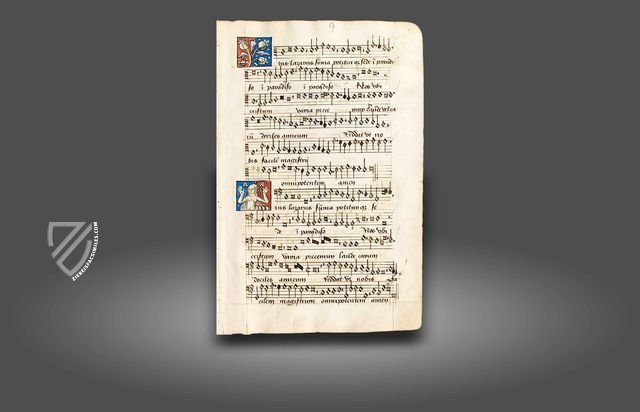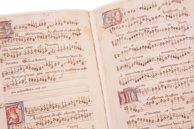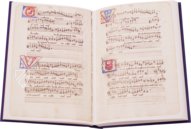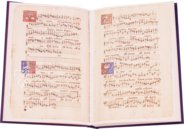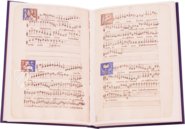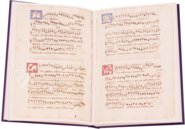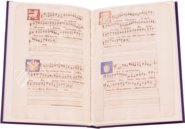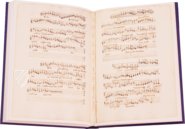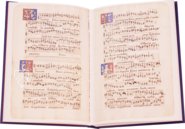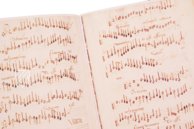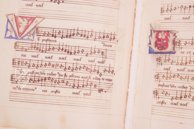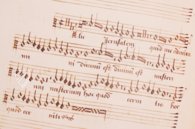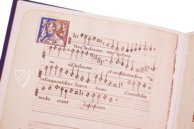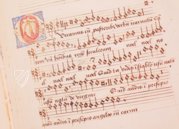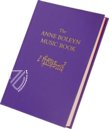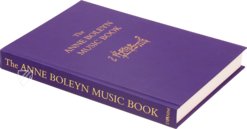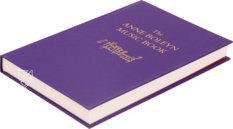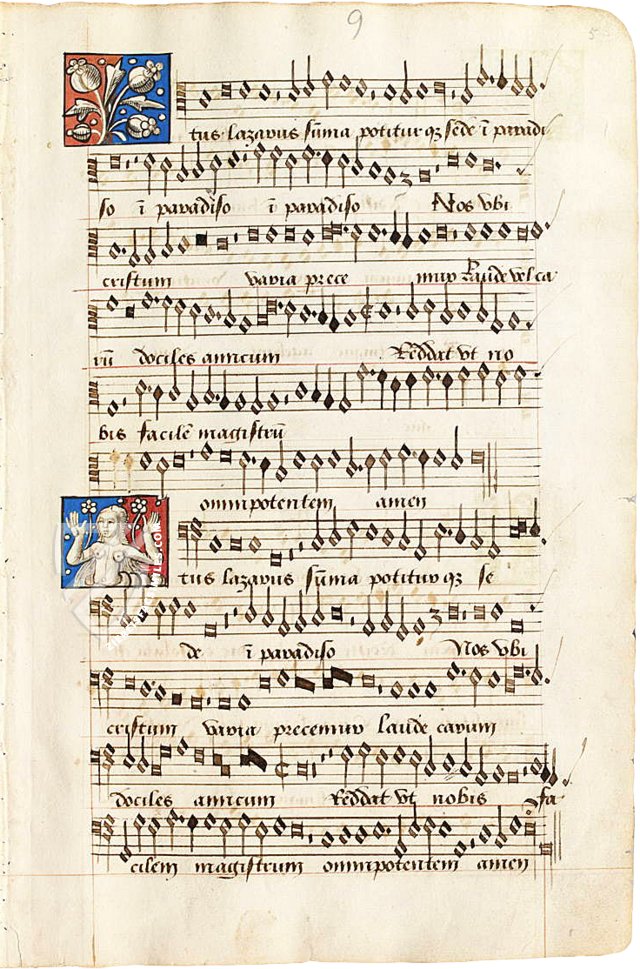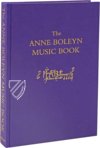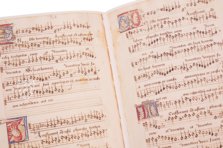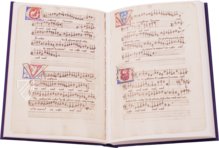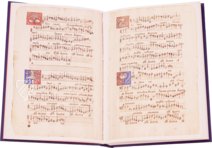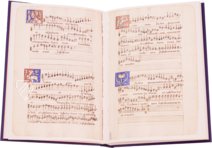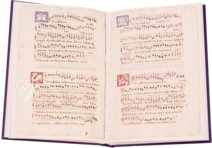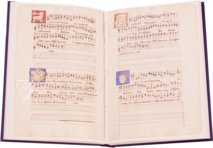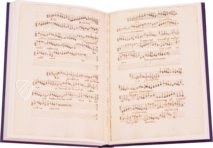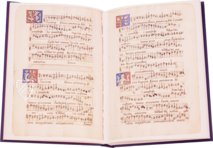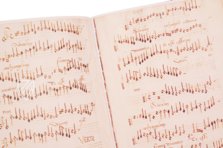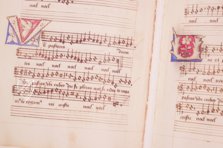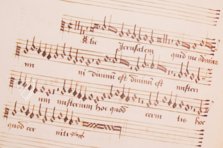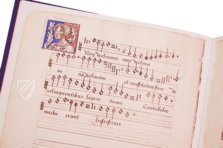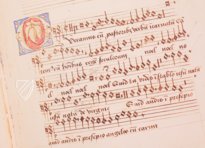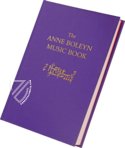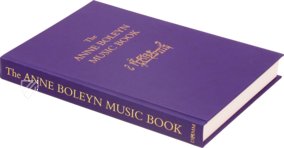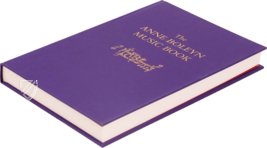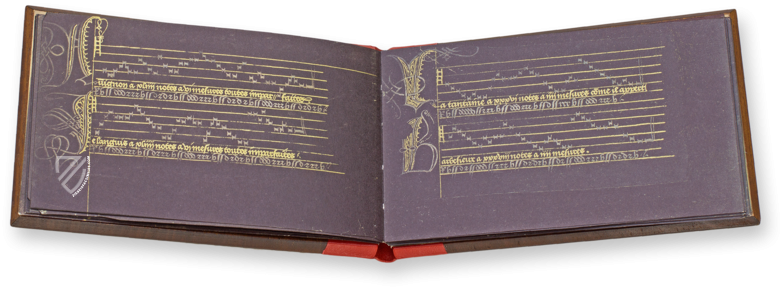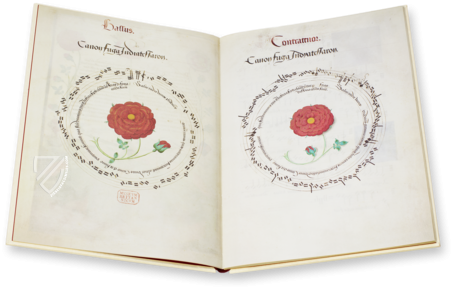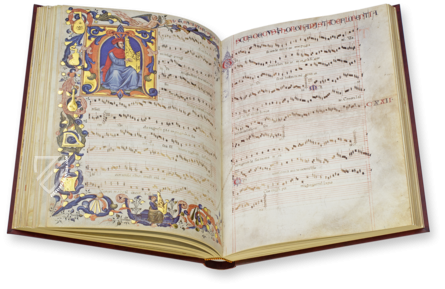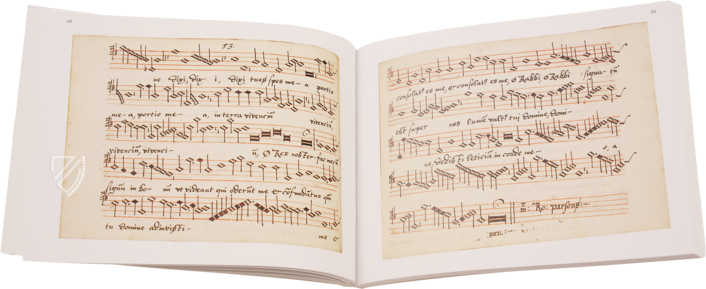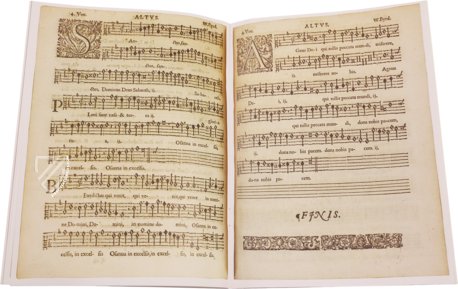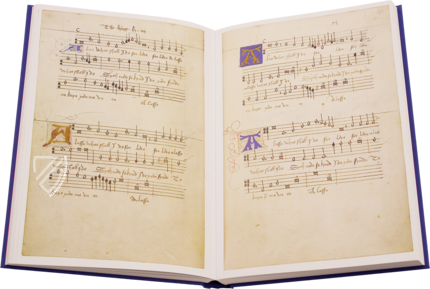Anne Boleyn's Book
(under 1,000€)
Anne Boleyn (ca. 1501–1536) is one of the most famous figures of the 16th century. Although she herself met a tragic end, her daughter Elizabeth (1533–1603) became one of the greatest monarchs in English history. This small but incredibly artful songbook bears an inscription with her name and can therefore be clearly attributed to the young Anne. At the same time, the manuscript was evidently created in France, which is why it still puzzles researchers to this day - how exactly are the music book and Anne Boleyn connected? What is certain is that it contains a truly unique collection of French Renaissance music, including pieces by the most significant contemporary composers, but also compositions that have survived exclusively in this manuscript. One or more of them may have been created by Margaret of Navarre and possibly even with the artistic participation of the cultivated Anne. A real gem of music history!
Anne Boleyn's Book
Anne Boleyn (ca. 1501-1536) is best known as the second wife of Henry VIII (1491-1547), Queen of England and mother of one of the greatest monarchs in English history - Queen Elizabeth I (1533-1603). However, she received her broad courtly and cultural education in Flanders and France. At around the age of 12, she came to Flanders as a lady-in-waiting to Margaret of Austria (1480-1530), where her musical talent is said to have been discovered and encouraged. Margaret was patroness to some of the most significant European composers of the early modern period. Anne was later a member of the French royal court, where she served as lady-in-waiting to Claude de France (1499-1524) and Renée de France (1510-1574).
A Unique Collection of French Renaissance Music
It was during this time that most of the so-called Anne Boleyn's Book was written. It comprises 54 compositions by at least 13 different contemporary composers - including 39 religious Latin motets and 3 French chansons. Particularly fascinating and significant are the remaining twelve compositions that are not (certainly) attributed, eight of which have survived exclusively in this manuscript. As the initials of Anne's friend Margaret of Navarre (1492-1549) appear in one chanson, it is conceivable that she created one or more of the anonymous pieces, possibly even together with Anne. As the king's sister, Margaret was highly educated and surrounded herself with great Renaissance thinkers throughout her life. The future Queen of Navarre was not only known as a patron of the arts, but also as an author of poems, plays and ballads herself.
A Personal Playlist
With this compilation of contemporary musical art, which was perhaps enriched with Anne Boleyn's favorite compositions, she returned to England in 1521/22, bringing a piece of French culture with her. The fact that the manuscript was in her possession is evident from an inscription on fol. 79. This reads: “Mris A Bolleyne nowe thus”, and contains her father's motto as well as her designation as mistress, which is why it must definitely have been entered before 1529. As the codicological features of the manuscript clearly indicate that it was written in France, it is conclusive that Anne Boleyn already called it her own during her time at the French court. She was obviously very fond of the art it contained, as some of the pieces were performed at her coronation as Queen of England in 1533.
The Work of Many Hands
A total of four scribes were involved in compiling the manuscript, which takes the form of a choir book in which each voice is written down separately. Each page comprises two parts, each of which is introduced by a champie initial. While the first and largest portion was completed by two hands in France between 1505 and 1513, two further hands added individual pieces to the codex at later points in the 16th century. Some of these show English notation practices, which is why it is assumed that they were added during Anne's time in England. The fascinating manuscript was probably in Anne Boleyn's personal possession until the violent end of her life by beheading and delighted the cultivated music lover.
Codicology
- Alternative Titles
- Anne Boleyn's Music Book
Musikbuch von Anne Boley
The Anne Boleyn Music Book - Size / Format
- 268 pages / 28.7 × 19.0 cm
- Origin
- France
- Date
- Ca. 1505–1536
- Epochs
- Style
- Genre
- Language
- Script
- Littera bastarda
- Illustrations
- Numerous decorated initials
- Content
- 54 pieces of music, including 39 religious motets and 3 chansons by 12 different composers as well as 12 pieces by anonymous creators
- Artist / School
- Mark Smeton (scribe)
Antoine Brumel (ca. 1460–ca. 1513) (composer)
Loyset Compère (ca. 1445–1518) (composer)
Josquin Despres (ca. 1450–1521) (composer)
Antoine de Fevin (ca. 1470–ca. 1512) (composer)
Mathieu Gascongne (fl. 1517-1518) (composer)
Pierre Moulu (ca. 1484–ca. 1550) (composer)
Jean Mouton (ca. 1459–1522) (composer)
Jacobus Obrecht (ca. 1457–1505) (composer)
Jean Richafort (ca. 1480–ca. 1550) (composer)
Claudin de Sermisy (ca. 1490–1562) (composer)
Pierrequin de Therache (ca. 1470–1528) (composer)
Jheronimus Vinders (fl. ca. 1525-1526) (composer) - Previous Owners
- Anne Boleyn
Robert William Haynes
Sacred Harmonic Society
William Pickering (1796–1854)
Anne Boleyn's Book
In illo tempore accesserunt
Fol. 12v shows two parts of the motet In illo tempore accesserunt, which is usually attributed to the Flemish cleric, composer and singer Jean Mouton (ca. 1459-1522) and can be found in several other manuscripts. However, Pierre Moulu (ca. 1484-ca. 1550) and Jheronimus Vinders (fl. ca. 1525-1526) are also discussed as authors.
The beginning of each part is marked by a small miniature, reminiscent of initials in their arrangement, but which contain only figurative depictions. While a female bust is inserted in the upper miniature, which was obviously intended by the scribe, as the scribal instruction above it shows, the lower miniature of a hybrid creature with two faces evokes associations with late medieval drôleries.
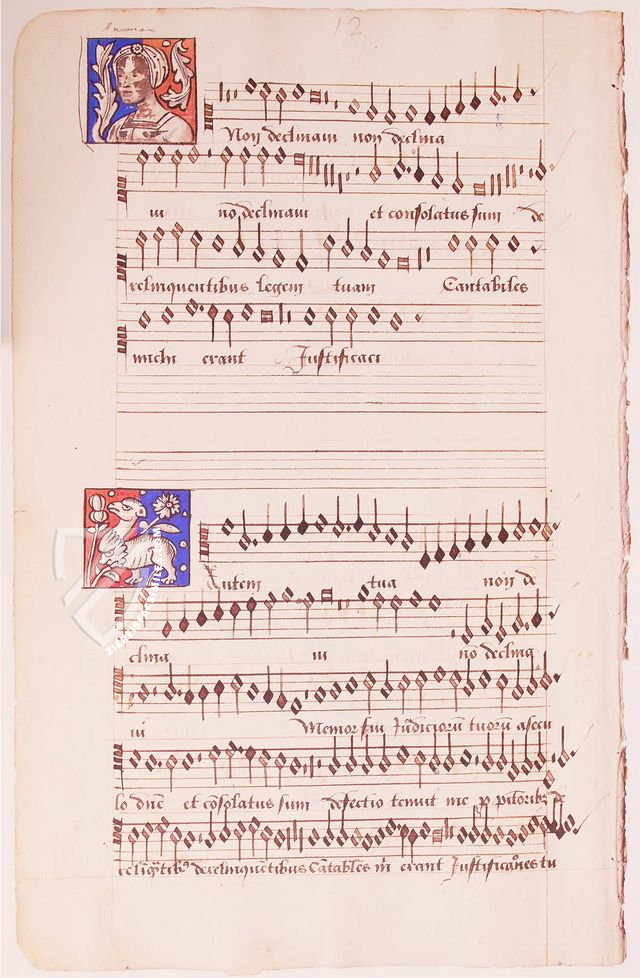
#1 The Anne Boleyn Music Book
Language: English
(under 1,000€)
- Treatises / Secular Books
- Apocalypses / Beatus
- Astronomy / Astrology
- Bestiaries
- Bibles / Gospels
- Chronicles / History / Law
- Geography / Maps
- Saints' Lives
- Islam / Oriental
- Judaism / Hebrew
- Single Leaf Collections
- Leonardo da Vinci
- Literature / Poetry
- Liturgical Manuscripts
- Medicine / Botany / Alchemy
- Music
- Mythology / Prophecies
- Psalters
- Other Religious Books
- Games / Hunting
- Private Devotion Books
- Other Genres
- Afghanistan
- Armenia
- Austria
- Belgium
- Belize
- Bosnia and Herzegovina
- China
- Colombia
- Costa Rica
- Croatia
- Cyprus
- Czech Republic
- Denmark
- Egypt
- El Salvador
- Ethiopia
- France
- Germany
- Greece
- Guatemala
- Honduras
- Hungary
- India
- Iran
- Iraq
- Israel
- Italy
- Japan
- Jordan
- Kazakhstan
- Kyrgyzstan
- Lebanon
- Liechtenstein
- Luxembourg
- Mexico
- Morocco
- Netherlands
- Palestine
- Panama
- Peru
- Poland
- Portugal
- Romania
- Russia
- Serbia
- Spain
- Sri Lanka
- Sweden
- Switzerland
- Syria
- Tajikistan
- Turkey
- Turkmenistan
- Ukraine
- United Kingdom
- United States
- Uzbekistan
- Vatican City
- A. Oosthoek, van Holkema & Warendorf
- Aboca Museum
- Ajuntament de Valencia
- Akademie Verlag
- Akademische Druck- u. Verlagsanstalt (ADEVA)
- Aldo Ausilio Editore - Bottega d’Erasmo
- Alecto Historical Editions
- Alkuin Verlag
- Almqvist & Wiksell
- Amilcare Pizzi
- Andreas & Andreas Verlagsbuchhandlung
- Archa 90
- Archiv Verlag
- Archivi Edizioni
- Arnold Verlag
- ARS
- Ars Magna
- ArtCodex
- AyN Ediciones
- Azimuth Editions
- Badenia Verlag
- Bärenreiter-Verlag
- Belser Verlag
- Belser Verlag / WK Wertkontor
- Benziger Verlag
- Bernardinum Wydawnictwo
- BiblioGemma
- Biblioteca Apostolica Vaticana (Vaticanstadt, Vaticanstadt)
- Bibliotheca Palatina Faksimile Verlag
- Bibliotheca Rara
- Boydell & Brewer
- Bramante Edizioni
- Bredius Genootschap
- Brepols Publishers
- British Library
- C. Weckesser
- Caixa Catalunya
- Canesi
- CAPSA, Ars Scriptoria
- Caratzas Brothers, Publishers
- Carus Verlag
- Casamassima Libri
- Centrum Cartographie Verlag GmbH
- Chavane Verlag
- Christian Brandstätter Verlag
- Circulo Cientifico
- Club Bibliófilo Versol
- Club du Livre
- CM Editores
- Collegium Graphicum
- Collezione Apocrifa Da Vinci
- Comissão Nacional para as Comemorações dos Descobrimentos Portugueses
- Coron Verlag
- Corvina
- CTHS
- D. S. Brewer
- Damon
- De Agostini/UTET
- De Nederlandsche Boekhandel
- De Schutter
- Deuschle & Stemmle
- Deutscher Verlag für Kunstwissenschaft
- DIAMM
- Droz
- E. Schreiber Graphische Kunstanstalten
- Ediciones Boreal
- Ediciones Grial
- Ediclube
- Edições Inapa
- Edilan
- Editalia
- Edition Deuschle
- Edition Georg Popp
- Edition Leipzig
- Edition Libri Illustri
- Editiones Reales Sitios S. L.
- Éditions de l'Oiseau Lyre
- Editions Medicina Rara
- Editorial Casariego
- Editorial Mintzoa
- Editrice Antenore
- Editrice Velar
- Edizioni Edison
- Egeria, S.L.
- Eikon Editores
- Electa
- Emery Walker Limited
- Enciclopèdia Catalana
- Eos-Verlag
- Ephesus Publishing
- Ernst Battenberg
- Eugrammia Press
- Extraordinary Editions
- Fackelverlag
- Facsimila Art & Edition
- Facsimile Editions Ltd.
- Facsimilia Art & Edition Ebert KG
- Faksimile Verlag
- Feuermann Verlag
- Folger Shakespeare Library
- Franco Cosimo Panini Editore
- Friedrich Wittig Verlag
- Fundación Hullera Vasco-Leonesa
- G. Braziller
- Gabriele Mazzotta Editore
- Gebr. Mann Verlag
- Gesellschaft für graphische Industrie
- Getty Research Institute
- Giovanni Domenico de Rossi
- Giunti Editore
- Graffiti
- Grafica European Center of Fine Arts
- Guido Pressler
- Guillermo Blazquez
- Gustav Kiepenheuer
- H. N. Abrams
- Harrassowitz
- Harvard University Press
- Helikon
- Hendrickson Publishers
- Henning Oppermann
- Herder Verlag
- Hes & De Graaf Publishers
- Hoepli
- Holbein-Verlag
- Houghton Library
- Hugo Schmidt Verlag
- Idion Verlag
- Il Bulino, edizioni d'arte
- ILte
- Imago
- Insel Verlag
- Insel-Verlag Anton Kippenberger
- Instituto de Estudios Altoaragoneses
- Instituto Nacional de Antropología e Historia
- Introligatornia Budnik Jerzy
- Istituto dell'Enciclopedia Italiana - Treccani
- Istituto Ellenico di Studi Bizantini e Postbizantini
- Istituto Geografico De Agostini
- Istituto Poligrafico e Zecca dello Stato
- Italarte Art Establishments
- Jan Thorbecke Verlag
- Johnson Reprint Corporation
- Josef Stocker
- Josef Stocker-Schmid
- Jugoslavija
- Karl W. Hiersemann
- Kasper Straube
- Kaydeda Ediciones
- Kindler Verlag / Coron Verlag
- Kodansha International Ltd.
- Konrad Kölbl Verlag
- Kurt Wolff Verlag
- La Liberia dello Stato
- La Linea Editrice
- La Meta Editore
- Lambert Schneider
- Landeskreditbank Baden-Württemberg
- Leo S. Olschki
- Les Incunables
- Liber Artis
- Library of Congress
- Libreria Musicale Italiana
- Lichtdruck
- Lito Immagine Editore
- Lumen Artis
- Lund Humphries
- M. Moleiro Editor
- Maison des Sciences de l'homme et de la société de Poitiers
- Manuscriptum
- Martinus Nijhoff
- Maruzen-Yushodo Co. Ltd.
- MASA
- Massada Publishers
- McGraw-Hill
- Metropolitan Museum of Art
- Militos
- Millennium Liber
- Müller & Schindler
- Nahar - Stavit
- Nahar and Steimatzky
- National Library of Wales
- Neri Pozza
- Nova Charta
- Oceanum Verlag
- Odeon
- Orbis Mediaevalis
- Orbis Pictus
- Österreichische Staatsdruckerei
- Oxford University Press
- Pageant Books
- Parzellers Buchverlag
- Patrimonio Ediciones
- Pattloch Verlag
- PIAF
- Pieper Verlag
- Plon-Nourrit et cie
- Poligrafiche Bolis
- Presses Universitaires de Strasbourg
- Prestel Verlag
- Princeton University Press
- Prisma Verlag
- Priuli & Verlucca, editori
- Pro Sport Verlag
- Propyläen Verlag
- Pytheas Books
- Quaternio Verlag Luzern
- Reales Sitios
- Recht-Verlag
- Reichert Verlag
- Reichsdruckerei
- Reprint Verlag
- Riehn & Reusch
- Roberto Vattori Editore
- Rosenkilde and Bagger
- Roxburghe Club
- Salerno Editrice
- Saltellus Press
- Sandoz
- Sarajevo Svjetlost
- Schöck ArtPrint Kft.
- Schulsinger Brothers
- Scolar Press
- Scrinium
- Scripta Maneant
- Scriptorium
- Shazar
- Siloé, arte y bibliofilia
- SISMEL - Edizioni del Galluzzo
- Sociedad Mexicana de Antropología
- Société des Bibliophiles & Iconophiles de Belgique
- Soncin Publishing
- Sorli Ediciones
- Stainer and Bell
- Studer
- Styria Verlag
- Sumptibus Pragopress
- Szegedi Tudomànyegyetem
- Taberna Libraria
- Tarshish Books
- Taschen
- Tempus Libri
- Testimonio Compañía Editorial
- Thames and Hudson
- The Clear Vue Publishing Partnership Limited
- The Facsimile Codex
- The Folio Society
- The Marquess of Normanby
- The Richard III and Yorkist History Trust
- Tip.Le.Co
- TouchArt
- TREC Publishing House
- TRI Publishing Co.
- Trident Editore
- Tuliba Collection
- Typis Regiae Officinae Polygraphicae
- Union Verlag Berlin
- Universidad de Granada
- University of California Press
- University of Chicago Press
- Urs Graf
- Vallecchi
- Van Wijnen
- VCH, Acta Humaniora
- VDI Verlag
- VEB Deutscher Verlag für Musik
- Verlag Anton Pustet / Andreas Verlag
- Verlag Bibliophile Drucke Josef Stocker
- Verlag der Münchner Drucke
- Verlag für Regionalgeschichte
- Verlag Styria
- Vicent Garcia Editores
- W. Turnowski Ltd.
- W. Turnowsky
- Waanders Printers
- Wiener Mechitharisten-Congregation (Wien, Österreich)
- Wissenschaftliche Buchgesellschaft
- Wissenschaftliche Verlagsgesellschaft
- Wydawnictwo Dolnoslaskie
- Xuntanza Editorial
- Zakład Narodowy
- Zollikofer AG

